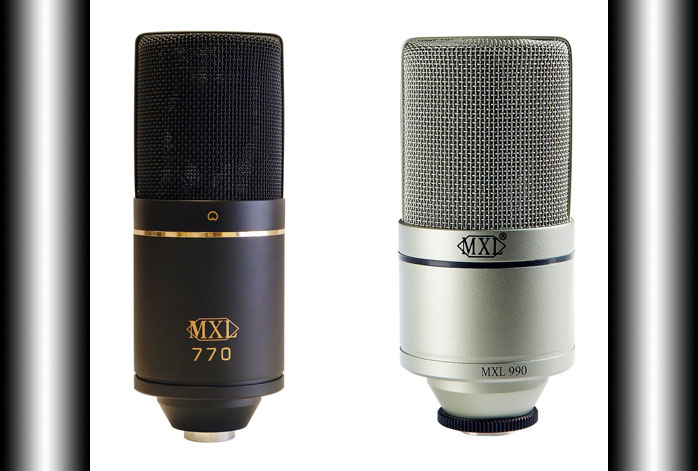Contents
Nowadays, once it comes to mics, people don’t have to worry about running out of options as the market is well-saturated. Still, it’s important to point out that a number of models stand out from the rest. Recently, MXL 770 and MXL 990 mics of MXL have caught the interest of the community owing to their fantastic performance. If you like both models but only need one mic, my article can help you determine the winner in MXL 770 vs. 990.
In-depth Comparison
Build
For your information, the biggest and most obvious difference between MXL 770 and 990 is their capsule size.
The 770 model is approximately 0.87 inches which technically fits into the definition of a large diaphragm. That being said, in reality, it is smaller than a standard large diaphragm which is around 1 inch. Compared to its predecessor, the MXL 990 model is noticeably larger at 1.26 inches. Consequently, it is bigger as well as heavier than the standard large diaphragm.
Noteworthily, in the grand scheme of things, the sizes of the capsules do not necessarily dictate their overall qualities. You must think about quite a few factors while comparing mics and “bigger is better” is not applicable here. The two mics utilize the same cardioid polar pattern so they effectively and efficiently record sounds from the front while eliminating sounds from behind. Unsurprisingly, a lot of people rate both models highly for home studio settings.
In terms of mount, MXL gives 770 and 990 shock mounts which is a big plus as condenser mics cannot handle too much abuse. MXL 770 features a shock mount on top of a custom-fitted hardshell case while MXL 990 comes alongside a custom shock mount, mic stand adapter and foam-padded case. Altogether, the two mics boast excellent protection and won’t get damaged by occasional bumps.
Power And Volume
Both modes share the same 48-volt phantom power requirement as a result of their condenser mic designs. The two mics also have identical 20 dB self-noise that keeps unwanted noises and artifacts out of your recordings.
About maximum sound pressure levels, MXL 770 is at 137 dB which is more than MXL 990 (130 dB). To put it plainly, a difference of 7 dB is not significant enough to give 770 a big advantage in MXL 770 vs. 990. However, on average, it’s wise to go for 770 if you need to record an instrument that’s particularly loud. Examples include electric guitars, bass cabinets, drums, saxophones, and so on.
Frequency Range
Another similarity shared between 770 and 990 is their frequency range, 20 Hz – 20 kHz, which is suitable for nearly every voice type and instrument. While MXL 770 demonstrates very high treble in the frequency response curve, it’s reported that MXL 990 actually provides a more exaggerated high-end.
Regardless, 770 packs a warmer and brighter tone compared to 990. In the case of low end, 770 emits a noticeable bump at around 100 Hz. Neither mic performs well below 80 Hz and thus they aren’t suitable for sounds with lots of subbass.
Sound
For sound, there is a feature that sets the two mics apart: 770 sports a -10 dB pad and a -6 dB per octave high-pass filter at 150 Hz. The former is a switch that lowers the overall gain by 10 dB while the latter is a filter that helps to clear sounds and tighten up the bass. The pad and filter usually come in handy as they improve the versatility of the 770 model.
The frequency bump at 100 Hz makes the 770 a superior choice when you need to cut through the mix. On the other hand, while 990 is regarded as the “all-rounder” option, it is muddier on top of being slightly harsh past 15 kHz. Naturally, it’s not uncommon to see people claiming that 770 is more suited for general-purpose applications.
| MXL 770 | MXL 990 | |
| Capsule size | 0.87 inches | 1.26 inches |
| Polar pattern | Cardioid | Cardioid |
| Protection | Shock mount and a custom-fitted hardshell case | Custom shock mount, mic stand adapter, and foam-padded case |
| Power | 48 volt | 48 volt |
| Maximum SQL | 137 dB | 130 dB |
| Tone | Brighter and warmer | Muddier |
| Additional features | A -10 dB pass and a -6 dB per octave high-pass filter | Unavailable |
Decision
MXL 770 by all accounts holds an edge once it comes to versatility and sound. Nonetheless, the muddier tone of the 990 might be desirable to musicians of certain tastes. At the end of the day, it comes down to individual liking and what you want out of your microphone. In use, they give a good account of themselves as budget mics (they cost less than $100 and there is only a minor $5-10 difference). Feel free to try them both and make up your mind.

Hi music fan! I am Jeff. Hope that you enjoy some stuff I shared here in my personal blog.
About myself, Currently I am in charging as Artist Manager/Music Supervisor at 72 Music Management. I did managed album to Grammy Award in 2017 with 7 Nominations from 2014-2020 and had the opportunities to work with : A.J. Croce, Blind Boys of Alabama, Bobby Rush, Dom Flemons, Dustbowl Revival, Sarah Grace
Governor of the Memphis Chapter of The Recording Academy is one of a award that I am lucky to achieved.

